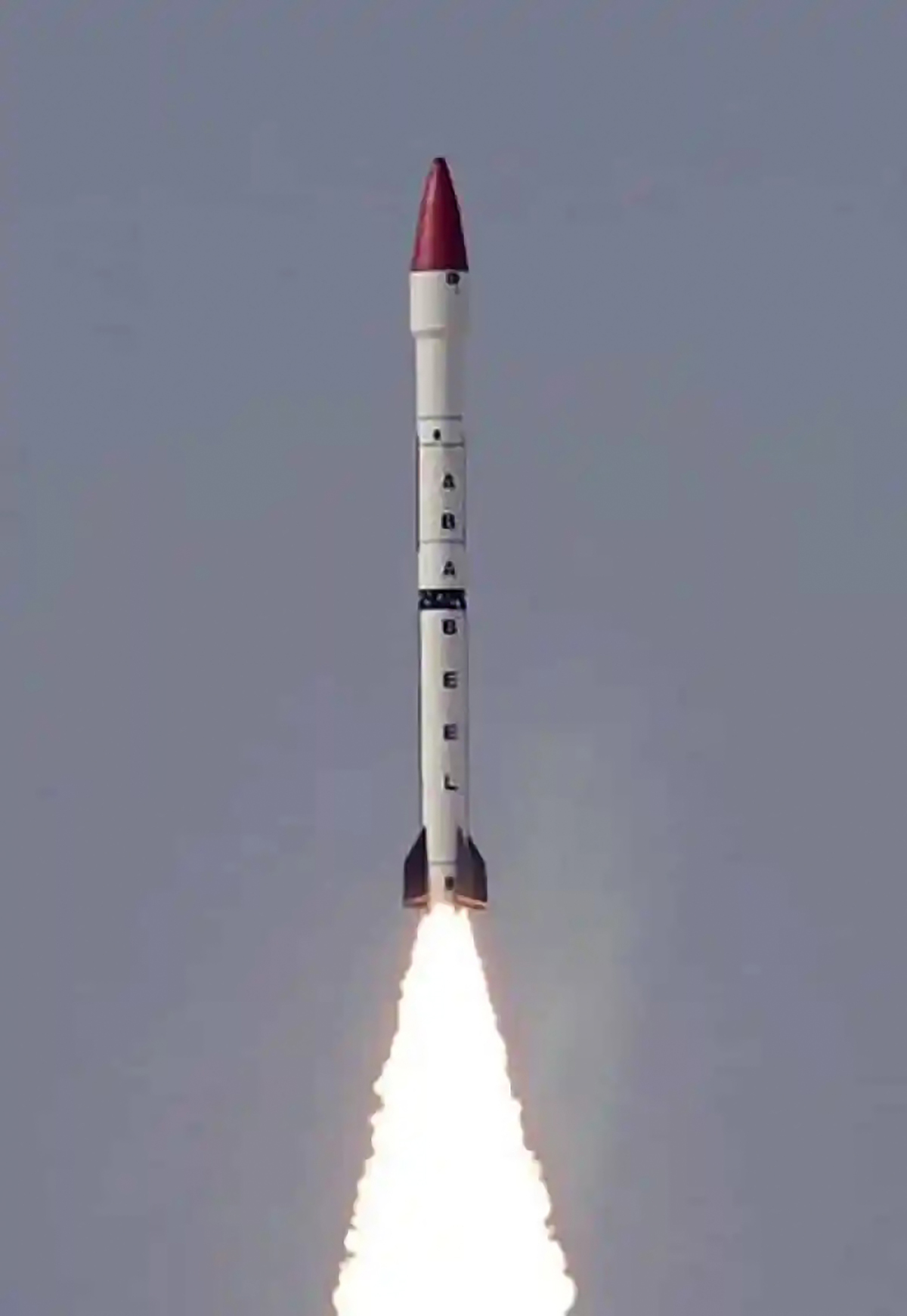Redefining National Security
By Interaction Team
The Ababeel Missile, developed by Pakistan, is a medium-range, surface-to-surface, ballistic missile. Its name is derived from the Holy Quran, symbolizing resistance, resilience, and national security. It plays a vital role in Pakistan’s defense strategy, reaffirming its commitment to a credible nuclear deterrent in a shifting regional security landscape.
Ababeel’s development
The origins of the Ababeel Missile can be traced back to the mid to late 2000s. Its design shares notable similarities with other solid-fuel Medium-Range Ballistic Missiles (MRBMs) in Pakistan’s arsenal, including the Shaheen II and Shaheen III, as well as the Chinese CSS-7 SRBM. What distinguishes the Ababeel missile is its remarkable capacity to accommodate Multiple Independent Reentry Vehicle (MIRV) warheads.
Mansoor Ahmed, an expert on Pakistan’s nuclear program, told Defense News after its second flight test that the Ababeel missile represents the “most important engineering milestone for Pakistan’s nuclear triad in almost two decades and a major breakthrough in improving the survivability of land-based strategic forces against a preemptive Indian counterforce strike.”
MIRV Technology
MIRV technology encompasses a set of nuclear or conventional warheads situated on the front section, commonly called the ‘bus,’ of a ballistic missile. With MIRVs, each warhead gains the ability to operate autonomously after the initial propulsion phases of the missile launch have concluded. These warheads can be separated from the bus at different speeds and along distinct trajectories.
Flight tests
The Ababeel’s first flight test occurred on January 24, 2017. The missile was launched from a site in Winder, on the southern coast of Pakistan. Recently, on October 18, 2023, Pakistan conducted another successful flight test of the Ababeel weapon system. The latest test, according to Pakistan’s Inter-Services Public Relations (ISPR), was aimed at “re-validating various design, technical parameters, and performance evaluation of different sub-systems.”
“The missile system is aimed at strengthening deterrence and enhancing strategic stability in the region through the operationalization of full spectrum deterrence in the overall construct of credible minimum deterrence,” the military’s media wing added.
Technical Specifications
The Ababeel missile is a three-stage, medium-range ballistic missile that boasts a maximum range of 2,200 kilometers (equivalent to about 1,367 miles). Its physical dimensions comprise a length of 21.5 meters, and the enlarged nose cone section of the missile is estimated to have a diameter of 1.7 meters.
According to ISPR, the Ababeel missile is not only capable of carrying nuclear warheads but also possesses the capability to engage multiple targets with a high degree of precision, effectively countering the radar systems of potential adversaries.
This missile can accommodate a total warhead weight of 1,500 kilograms (or 3,307 pounds), which can be configured as either three standard warheads, each weighing 500 kilograms, five warheads weighing 300 kilograms each, or a maximum of eight warheads, each with a weight of 185 kilograms.
The Ababeel missile employs solid-fuel technology, which provides several advantages in terms of reliability, responsiveness, ease of transportation, and launch readiness when compared to liquid-fueled missiles.
Role in Pakistan’s defense strategy
While it’s true that since 2010, many analysts have examined the potential ramifications of the proliferation of MIRVs in Asia, the ISPR has unequivocally stated that the development of an MIRV-capable missile has the primary goal of guaranteeing the survivability of Pakistan’s ballistic missiles in response to the expanding regional Ballistic Missile Defense (BMD) environment.
The Ababeel missile system plays a multifaceted role in Pakistan’s deterrence strategy, fulfilling a range of crucial objectives:
- Deterrence
The primary objective of Pakistan’s nuclear weapons program, including the Ababeel missile, is to deter potential adversaries from initiating aggressive actions. The missile’s extended range and advanced capabilities provide Pakistan with a credible deterrent against potential threats.
- Strategic balance
In a region, characterized by strategic rivalries, possessing a robust missile system like the Ababeel missile helps Pakistan uphold power equilibrium, foster strategic stability, and mitigate the potential for regional conflicts.
- Counterforce capability
The Ababeel missile’s MIRV capability enhances Pakistan’s ability to enhance its counterforce competencies, allowing for the effective targeting and neutralization of enemy military assets in the event of a conflict
- Second-Strike capability
The survivability and mobility of the Ababeel missile system make it a dynamic component of Pakistan’s second-strike capability. In the event of nuclear aggression, the Ababeel missile can be launched from concealed or protected locations, ensuring a retaliatory response even after a first strike.
Regional and International implications
The deployment of the Ababeel missile carries substantial regional and international significance. Firstly, it plays a vital role in preserving strategic parity within South Asia, where both Pakistan and India possess nuclear capabilities.
his equilibrium is essential for upholding regional stability. Additionally, the Ababeel missile’s presence underscores the critical importance of arms control and non-proliferation initiatives. It accentuates the necessity for confidence-building measures and dialogues among regional powers to mitigate the risk of potential conflicts.
Conclusion
In an ever-evolving security landscape, the Ababeel missile serves as a reminder of the intricate dynamics and challenges nations face in pursuit of security and deterrence in an uncertain world. It is imperative for policymakers, analysts, and stakeholders to thoughtfully assess the consequences of advanced missile systems in influencing regional and global security strategies.
As the global security landscape continues to evolve, Pakistan’s Ababeel missile remains a crucial component of the nation’s defense strategy, embodying its commitment to security and deterrence.


